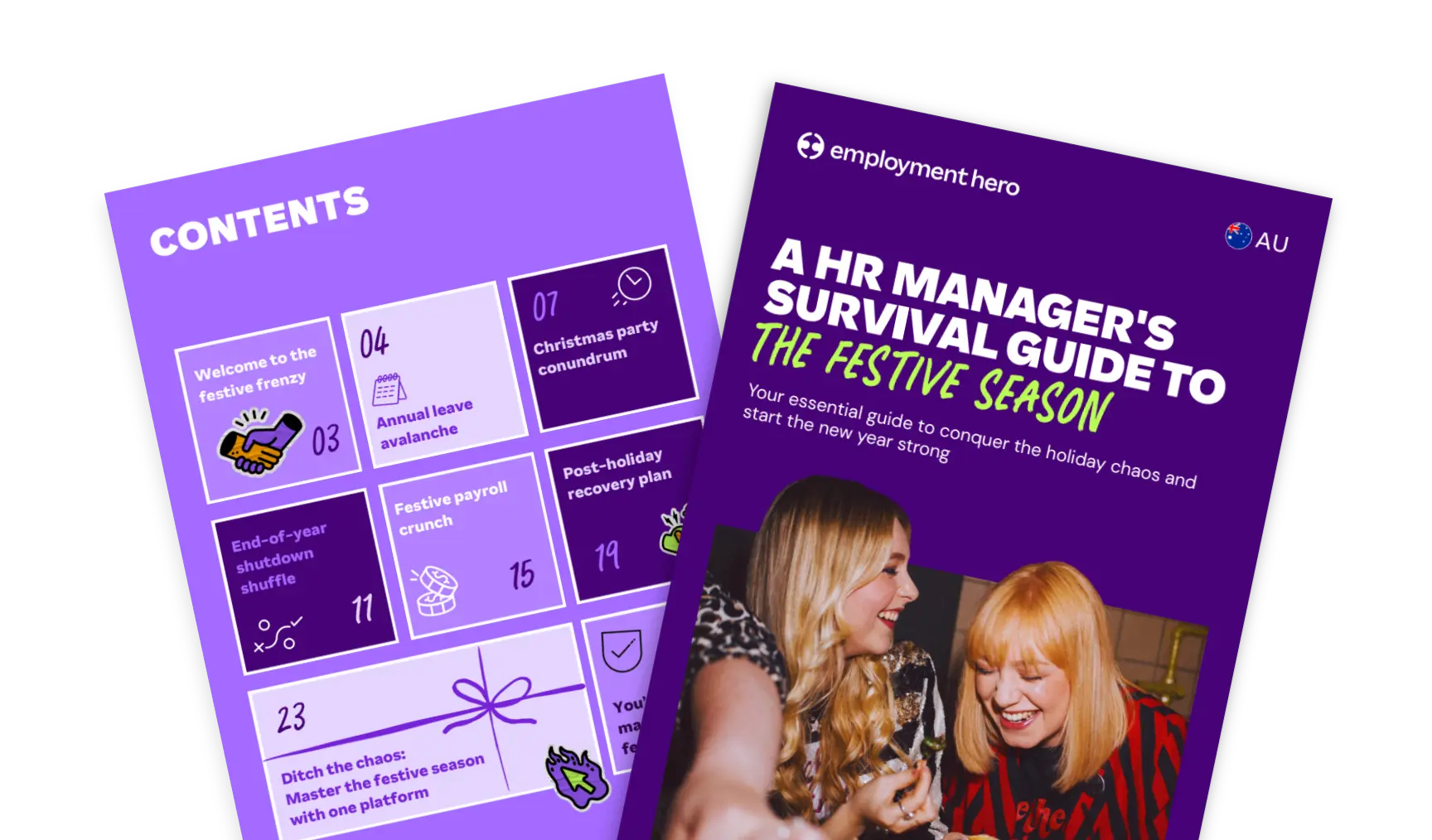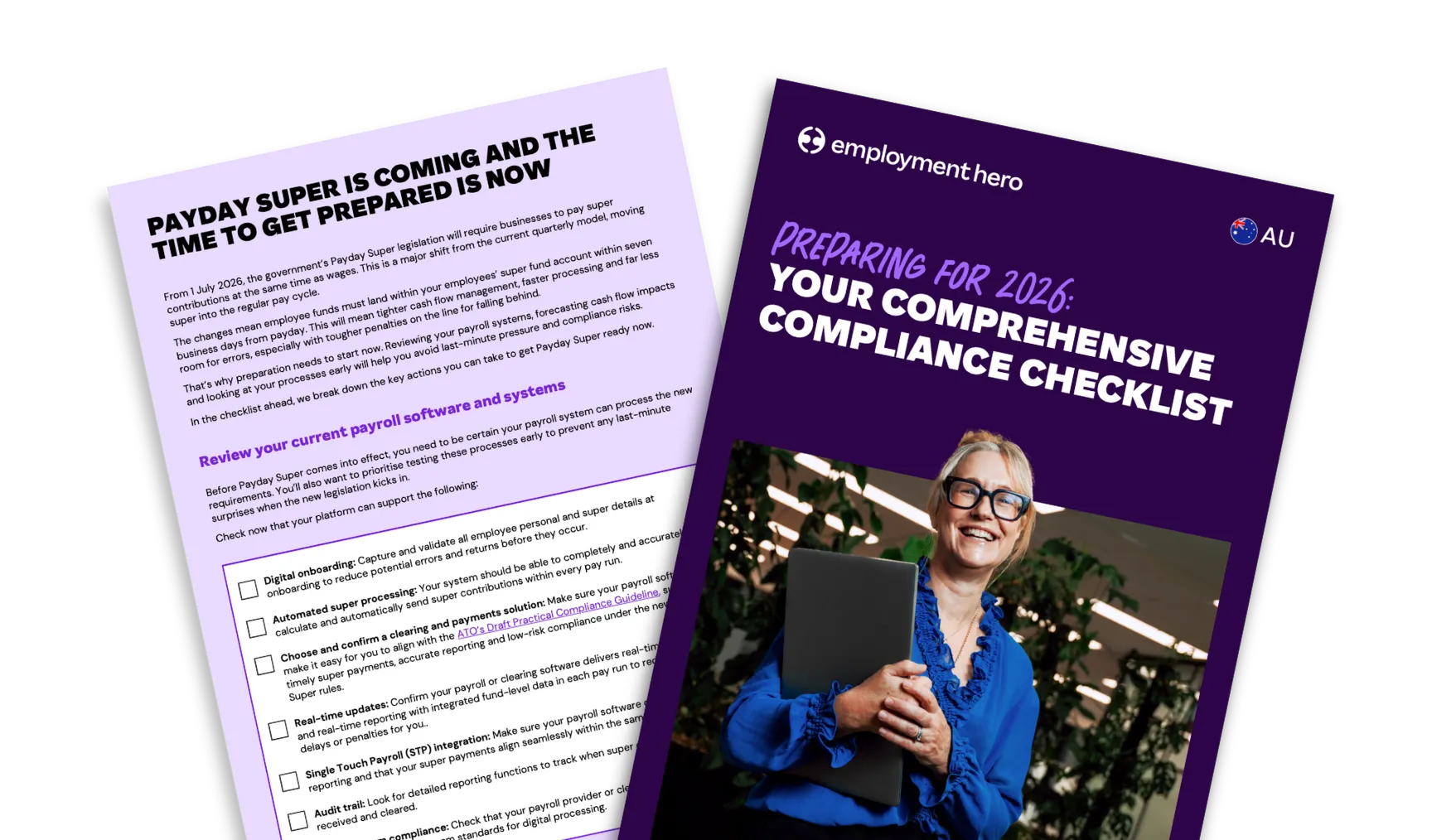A comprehensive guide to HR technology
Published
A comprehensive guide to HR technology
What’s in this guide?
The HR technology landscape is constantly evolving, transforming from basic digital personnel records to integrated platforms that support every aspect of the employee journey.
HR teams can now handle what once buried them under paperwork with a few clicks, creating breathing room for the work that really matters, focusing on your people.
In this guide, we’ll cover:
- What HR technology is and how it’s reshaping HR operations in organisations of all sizes, from manual filing cabinets to digital systems accessible anywhere
- The real-world benefits HR tech brings to Australian businesses, showing the shift from reactive management to data-informed decision-making
- How artificial intelligence (AI) is changing HR practices and what this means for your day-to-day work
- A practical approach to picking HR tech solutions that actually fit your business needs (without getting lost in features you’ll never use)
- Straightforward strategies for connecting your core HR technology systems to create a seamless experience
- Tips for successful implementation that turn potential resistance into enthusiastic adoption
Whether you’re looking to replace outdated systems or build your HR tech stack from scratch, finding the right HR software involves understanding what your organisation needs today and where it’s heading tomorrow.
The following sections will walk you through this process, helping you make choices that create genuine improvements for both your HR team and your entire workforce.
But first, the basics.
What is HR tech?
HR technology, or HR tech for short, is the digital tools and platforms that help manage everything people-related in your organisation. These solutions handle all sorts of HR processes: think applicant tracking systems, talent management, managing employee records, processing payroll, supporting performance reviews and so much more.
At its core, HR tech is all about making people management easier and more efficient.
For instance, you might use standalone tools for specific needs or comprehensive HR platforms that cover the whole employee journey. Some companies start with just a recruitment system or a digital onboarding process, while others implement robust HR software that connects everything in one place.
What’s really valuable about good HR tech is how it transforms what your HR team can accomplish; developing your people, improving company culture, and contributing to business strategy with valuable data-driven insights.
As Australian businesses face tighter labour markets and evolving workplace expectations, having the right tech to support your HR operations isn’t just a nice-to-have anymore.
What benefits does HR tech bring to Australian businesses?
Remember that frustrating week when your entire HR team was buried in paperwork for the annual compliance review? Or that talented candidate who slipped through the cracks because your recruitment process moved too slowly? These aren’t just annoying workplace stories, they’re symptoms of HR systems that haven’t kept pace with today’s business needs.
But this can be a thing of the past. Let’s look at how these HR tech can transform your workplace.
Improving the employee experience
HR technology creates seamless experiences throughout the employee journey. From applying for a role to requesting leave or accessing learning resources, well-designed HR tech puts employees in control of their work lives. For Australian workforces, especially those with remote work or flexible arrangements, this accessibility transforms the daily experience of work.
The real transformation happens when employees view HR processes as tools that actually help them succeed. When team members can easily update their details, schedule time off without lengthy approval chains, or find learning opportunities that match their career goals, they spend less time navigating bureaucracy and more time doing meaningful work.
Leveraging employee data
Behind every HR decision should be solid insights rather than guesswork. HR technology gives you the power to collect, analyse and act on workforce data that previously remained hidden in spreadsheets and filing cabinets. Relying on clear, data-driven insights rather than guesswork leads to smarter HR decisions. It also helps protect your business by improving compliance, reducing risk, and supporting your actions with real evidence.
Good HR tech connects information across the employee lifecycle, revealing patterns you’d otherwise miss. You can track which qualities predict success in different roles, identify early signs of disengagement before people leave, and understand exactly where your skills gaps are developing.
For HR teams ready to move beyond administrative functions, this data capability is transformative. It allows you to spot issues before they become problems, back up your recommendations with solid evidence, and measure the actual impact of your people initiatives.
Reducing administrative tasks for HR departments
As an HR professional or business leader, paperwork will inevitably top the list of your biggest frustrations. The endless cycle of processing forms, chasing approvals, and updating records steals time from the meaningful human work that attracted people to HR in the first place. HR technology breaks this cycle by automating repetitive tasks that drain time and energy.
When onboarding, leave management, and routine approvals happen through digital workflows, your HR team escapes the administrative quicksand.
Think of what your HR professionals could accomplish if they reclaimed half their week from processing and paperwork. How would their contributions to your business change if they had time to focus on enhancing culture, developing leaders, or improving engagement?
Elevating performance management
Performance management systems now support ongoing conversations, real-time feedback, and continuous goal tracking. Managers can acknowledge achievements when they happen, address issues before they escalate, and help team members stay aligned with evolving priorities.
For Australian businesses building performance cultures, this shift from annual events to ongoing dialogue represents a fundamental improvement. When feedback becomes a natural part of work rather than a dreaded formal process, performance becomes a journey of continuous improvement rather than a periodic judgment.
How is AI transforming HR technology and practices?
With 86% of HR leaders already using AI-powered software, artificial intelligence has moved beyond theoretical applications to become a practical reality in HR departments across Australia.
The value of AI in HR is how it handles the time-consuming, repetitive parts of people management while freeing HR professionals to focus on the uniquely human aspects of their role.
Let’s look at how AI is reshaping different aspects of HR work:
Talent acquisition and recruitment
AI tools now screen resumes, match candidates to job requirements, and even write job descriptions that attract more diverse applicants. Some systems can predict which candidates are most likely to succeed in specific roles based on data from your existing top performers.
Interested in learning more? Our AI-powered recruitment tool, SmartMatch, along with our applicant tracking system, does just that and so much more. It matches you with qualified, work-ready candidates, ready to go when you are.
Employee onboarding and learning
Personalised learning platforms use AI to recommend training based on an employee’s role, skill gaps, and career aspirations. AI-powered onboarding tools can customise the experience for each new hire, ensuring they receive the right information at the right time.
Performance management
From analysing communication patterns to identifying collaboration barriers to providing real-time coaching suggestions for managers, AI helps make performance conversations more objective and effective.
Employee experience and wellbeing
Sentiment analysis tools can spot early signs of disengagement in survey responses, while smart chatbots provide 24/7 support for common HR queries (like our very own HeroAI), reducing wait times and frustration.
Workforce planning and analytics
AI excels at identifying patterns in large datasets, helping HR teams predict future hiring needs, retention risks, and skill requirements before they become urgent problems.
Administrative automation
Perhaps the most immediate benefit is AI’s ability to handle routine paperwork. From payroll processing to managing leave requests, it can do it with greater speed and accuracy than human processing.
What makes AI particularly valuable in the Australian context is how it helps businesses navigate our unique challenges: managing geographically dispersed teams across vast distances, addressing skills shortages in key sectors, and maintaining compliance with complex workplace regulations that vary across states and territories.
The companies getting real results aren’t just bolting AI onto their existing HR systems as an afterthought. They’re weaving it deeply into their entire HR tech setup. Instead of seeing AI as something that might replace their people, they’re using it to make their HR teams even better at what they do.
When they connect their AI tools with their core HR and employment systems, insights from one area automatically flow into actions in another, whether that’s finding great candidates, developing team members, keeping people engaged, or holding onto key talent.
How to choose the right HR tech for your business
With hundreds of HR tech solutions available, finding your perfect match requires a balance of your current requirements with your future aspirations.
When evaluating HR technology for your organisation, focus on these key considerations:
Start with your pain points, not features
The most impressive feature list means nothing if it doesn’t solve your actual problems. Begin by documenting your specific challenges: Is recruitment taking too long? Are employee records scattered across multiple systems? Are managers struggling with performance conversations? Let these pain points guide your search.
Consider your entire employee journey
Look for technology that supports the complete lifecycle from recruitment through to retirement. Even if you’re only addressing one area now (like employee onboarding), choose solutions that can grow with you or integrate with other systems as your needs evolve.
Prioritise user experience
The most powerful HR system delivers zero value if people won’t use it. Evaluate the interface through the eyes of your least tech-savvy employees. Is it intuitive? Can people find what they need without training? Remember that HR technology serves your entire workforce, not just your HR team.
Verify integration capabilities
Your HR technology needs to connect with your existing systems. Confirm exactly how the solution handles data exchange with your payroll, learning platforms, or other core systems. Ask for specific examples of successful integrations with systems similar to yours.
Calculate the true cost
Look beyond the initial price tag to understand the total investment. Factor in implementation services, ongoing support, future upgrades, additional modules you might need, and internal resources required to maintain the system.
You should also consider implementation requirements, security and compliance features, scalability for future growth, quality of customer support, and feedback from existing customers. These factors ensure your chosen HR tech solution delivers long-term value, preventing it from becoming another underutilised system that frustrates your team and drains resources.
That’s why it is crucial to take your time, involve stakeholders from across your business, and focus on finding technology that adapts to your way of working rather than forcing your people to adapt to the technology.
Integrating core HR technology systems for HR functions
Most HR departments today are struggling with too many disconnected systems that don’t talk to each other. The recruitment team works in one system, payroll in another, learning in a third, and performance management somewhere else entirely. The result? Duplicate data entry, inconsistent information, and a fragmented view of your workforce.
Integration breaks down these digital walls to create a seamless flow of information across your HR functions. When your core HR technology systems work together, everything changes. Here’s just a few benefits you can expect to see.
Employee data remains consistent and current
When an employee updates their address in the self-service portal, that information automatically flows to payroll, benefits, and other systems without manual re-entry or reconciliation.
Processes flow across system boundaries
Onboarding a new hire triggers the right actions in multiple systems: their profile is created in the HRIS, learning plans are assigned, payroll is updated, and equipment is requested, all from a single workflow.
Reporting draws from a complete dataset
With all your data in one place, your reports will be clearer and show you valuable information you’d otherwise miss.
Employee experience becomes coherent
Rather than navigating multiple login credentials and interfaces, employees can access what they need through a single digital front door with consistent design and navigation.
Connecting your HR systems eliminates the frustrating data gaps, duplicate entries, and disjointed experiences that waste your team’s time and test your employees’ patience.
Keen to take your HR digital?
Whether you’re taking your first steps into HR tech or trying to connect systems that just won’t talk to each other, download this guide as you navigate your options.
If you’re ready to explore an end-to-end employment solution, take a look at our Employment Operating System. It has everything you need to take your HR digital and streamline all the time-consuming and confusing parts of employment. And if you are looking for expert HR support, our HR advisory team is here to help.
To download the guide, we just need a few quick details.
Related Resources
-
 Read more: HR Managers: Don’t just survive the festive season, master it
Read more: HR Managers: Don’t just survive the festive season, master itHR Managers: Don’t just survive the festive season, master it
Make year-end easier: manage leave, payroll, parties and shutdowns with confidence. Get practical tips for Australian SMEs. Download the free…
-
 Read more: Preparing for 2026: Your Compliance Checklist
Read more: Preparing for 2026: Your Compliance ChecklistPreparing for 2026: Your Compliance Checklist
Get your business ready for the 1 July 2026 changes. See practical steps for Payday Super, cash flow planning and…
-
 Read more: Monthly business budget template for employers
Read more: Monthly business budget template for employersMonthly business budget template for employers
Plan your monthly income and expenses with our free monthly business budget template. Download today to track cash flow and…























